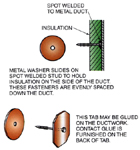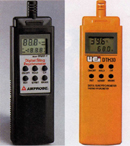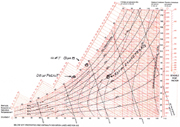Bob got a call from the dispatcher that a new customer, a restaurant, has some ductwork in the dining room that has been sweating during the lunch hour for the last several days and dripping on the customers. It was about lunchtime so Bob went to the restaurant to check it out. It was good that he was going to be there when the sweating is actually happening.
He arrived to find that, sure enough, the duct was sweating and dripping on some of the tables. The restaurant owner had to discontinue the use of some of the tables until this problem could be solved and he noted that those tables were really needed because he gets a big crowd for lunch.

Figure 1. This illustration shows how duct lining may be fastened to the inside of metal duct. (Figures are from Refrigeration & Air Conditioning Technology, 5th Edition, by William Whitman, William Johnson, and John Tomczyk, published by Delmar Cengage Learning.) (©Delmar Cengage Learning.) (Click on the image for an enlarged view.)
“What is the problem, Bob?” Btu Buddy asked.
Bob said, “The duct in the dining room is sweating and the duct is insulated. It does not seem to be sweating here in the storage room. I can’t figure out why.”
Btu Buddy then said, “There are at least two things that may be going on here:
• The air is too humid.
• The duct is too cold.
Look at all of the hot food coming out of that kitchen, there is steam rising off of all of it. I would suspect that the humidity is really high. Maybe you should ask the owner when he turned the air conditioning unit on. It is possible that it was very humid when the crowd arrived and the unit just hasn’t had time to pull the humidity out of the air. You might also ask him how long this has been happening and has it ever happened before.”
Bob talked to the owner and found out that the unit had been on all morning. He also found out that the duct had started dripping for the first time last week. Up until then, all was well.
Btu Buddy then said, “Let’s rule out too much humidity in the air and investigate how cold the air stream is in the duct. What could cause the air stream to be too cold?”
Bob said, “Not enough airflow across the coil, or a dirty coil which would reduce the airflow. I think I will start with the air filters.”
Bob checked the air filters and found them to be in good shape.
Btu Buddy then suggested that Bob check the air temperature at the first register. He asked Bob, “What is the approximate temperature that the air should be?”
Bob said, “I noticed that the room thermostat thermometer read 76°F. There is a real crowd in the dining room. The coil should have about a 20° temperature drop, so I would guess that the duct air temperature should be about 56°.”

Figure 2. Shown are two electronic psychrometers. (©Delmar Cengage Learning.) (Click on the image for an enlarged view.)
Bob put his temperature tester in the register and said, “Wow, the temperature of the air stream is 48°. That is way too cold.”
Btu Buddy then said, “Let’s see what the actual dry bulb and dew point temperature of the air in the room is.”
Bob got out his psychrometer (Figure 2) and checked the conditions of the room air and found them to be 76° dry bulb and 63.2° wet bulb. This would make the dew point temperature 56.5° (Figure 3).
Bob then asked, “Does this mean that if the outside temperature of the duct is below 56.5° that the duct will sweat?”
Btu Buddy said, “Yes, it does. With the air inside the duct at 48°, you can bet that the outside of the duct is below 56.5°, even with insulation. Now, we have to determine why the air in the duct is so cold.”

Figure 3. Psychrometric chart. (©Delmar Cengage Learning.) (Click on the image for an enlarged view.)
Bob looked around and found that the return air grille was almost closed. The louvers were movable and they were almost closed due to someone closing them to clean them and leaving them closed.
Bob said, “This must be the problem. I am surprised that I didn’t catch this when I walked in. They were closed to the point that the air was making a whistling sound going through them. I guess the background noise covered it up.”
Btu Buddy then remarked, “You really do need to use your senses to find all of the problems some of the time.”
Bob opened the louvers and then checked the air temperature in the duct and it had gone up to 55°. He then said, “I believe this will stop the duct from dripping, but I still do not really understand this dew point thing.”
Btu Buddy said, “Let’s meet here for lunch tomorrow for a simple lesson in dew point temperature. That will give you a chance to follow up on this system and have a lesson also.”
Bob showed the owner what the problem was and he was glad that the fix was so simple.
Btu Buddy then said, “You have another happy customer for your company.”
Publication date:09/21/2009


Report Abusive Comment